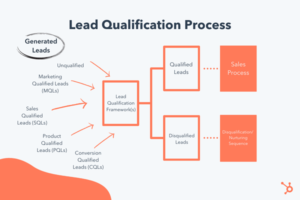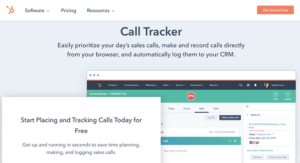Your sales pitch can make or break the deal, so it’s a good idea to have that nailed down before meeting with your customer. It’s your opening line, your verbal business card, and the first thing your customer will hear when you call or meet with them.
I’ve been in sales for almost 16 years and have heard my fair share of both great and less-than-stellar pitches.
For this post, I’d like to discuss the anatomy of a good sales pitch and share examples of the best sales pitches I’ve ever heard.
Salespeople are past the point of giving prospects hour-long presentations to sell products or services. Nobody has that kind of time and, to be honest, if you need an hour to relay your value proposition, you’re doing it wrong.
They’re called elevator pitches for a reason. Ideally, if you’re giving me one, I should be able to understand what you have to offer in the time it takes to get from the lobby to my floor.
A good salesperson should be able to get their message across compellingly and concisely. If you can nail your sales pitch, odds are you’ll have more time to talk down the line.
What is a product pitch?
A product pitch is not much different than a sales pitch, but is specifically focused on a product or service. You’ll go in-depth and emphasize how your product works, how it will solve their pain points, and the specific benefits it will bring to your customers.
As an example, a sales pitch can be broadly focused, like if you’re a consulting firm that offers a wide range of services. You’re selling your business as a whole, rather than a specific product or service, like a CRM platform or accounting tool.
How to Start a Pitch
Starting a pitch is arguably the hardest part. You have to grab your prospect’s attention so that they actually want to hear the value of your product and how it can help their business. But before you can share the product’s value, you have to hook the prospect.
When starting your pitch, you’ll want to integrate the following essential elements.
- Start with the problem. Always start with the problem. Unless they know the problem you can solve, they won’t be open to hearing how your product is a solution.
- Tailor the start of the pitch to their vertical. No one wants to hear a general pitch that would apply to any business. Research their vertical and use the information you found to personalize the pitch immediately.
- Offer stakes. If they don’t solve the problem using your solution, what do they have to lose? You don’t need to state it in such clear terms — but alluding to the risks at the start of your pitch can help you secure buy-in straightaway.
Here are a few methods for starting a product pitch, but remember: try to stick to thirty seconds, or one to two sentences if you’re delivering the pitch via email.
Start off with a personal anecdote.
Start off a pitch with what you know best — yourself. While I don’t think you should focus solely on yourself throughout your entire pitch, starting off with a personal anecdote can help you speak with more authenticity and foster empathy.
The key here isn’t to focus on the product’s merits. How many product pitches start off with “This product helped me achieve X results in X amount of time”? A lot. And I’m already yawning. And no one cares about results unless they know the problem first.
Your personal anecdote should focus on a problem that your product can solve. Make it as excruciating as you’d like — and don’t forget to be genuine and connect your anecdote to their business.
Ask a question that relates to the problem you solve.
Oh, yes, the good old question. While it might verge on overused, it’s not to be dismissed. Asking a question is a highly effective way to start a pitch. The question should, again, focus on the problem.
Stick to yes or no questions and tailor it specifically to the business you’re pitching to. If you’re speaking to a real estate business, create a question that articulates a problem specifically experienced by real estate firms. If you sell a property management software, it could be as simple as, “Do you spend way too much time tracking individual property sales? That’s time better spent actually showing homes to prospective buyers.”
Start with a stat that resonates and offers stakes.
Starting with a stat can be effective — but it has to resonate with the audience and offer stakes. In other words, what does the stat have to do with the problem? How does it reflect a potential and critical downfall that could harm your prospect?
Let’s say that you’re a salesman of yard maintenance services. Starting off with “50% of homes don’t use yard maintenance services” is a lazy and boring way to begin your pitch. Consider instead: “50% of homes don’t use yard maintenance services, resulting in thousands paid to HOA every year.”
Now that you know how to start your pitch, it’s time to deliver the rest of it. Use the following tips to secure buy-in in less than three minutes.
1. Make it short.
A sales pitch isn’t a conventional presentation. You’re not going to have PowerPoint slides. You’re not going to have complimentary pastries on a boardroom table. And, most of all, you’re not going to have your audience’s time and patience for long — at least not until they’re sold on your product.
2. Make it clear.
This ties in with the previous point. You don’t have the time to go on tangents or talk about anything but the message you’re trying to get across. Your pitch has to be lean and to the point. It has to register with your listener immediately. That means speaking with intention and clarity.
If you’re pitching a product, you want to ensure that you clearly communicate how it will solve your prospects’ pain points, giving them a clear picture of how their day-to-day will improve if they decide to make a purchase.
3. Explain who your customers are.
Consider the picture you’re going to paint in your pitch. Give your listeners perspective on who’s buying your product or service. They want to know that you have a lucrative, engaged market in mind. Be specific in identifying who will be interested in your product, and try to convey why your listeners should be interested in them.
4. Explain the problem they’re facing.
Cover why your customer base needs you. Your target market is only as valuable as the problems you can solve for them. Convey a problem they consistently face. If you’re pitching a spreadsheet software for accountants with functionality Excel doesn’t have, you could discuss how hard it is to bookkeep without your software’s unique features.
5. Explain how your product addresses their needs.
Here’s where you start to bring it all home. You’ve established who you’re selling to. You’ve established why you’re selling to them. Now, you have to establish why they’d buy from you. What can you do better than your competition?
As mentioned above, you need to clearly explain how your product addresses their needs. Continuing with the accounting example, you could touch on how your unique data visualization features make busywork more efficient.
6. Describe what success what success with your product will look like.
Show the benefits of your product on a broader scale. In the example we’ve been using, you can talk about how accountants that use your software have more time to spend with important clients or the flexibility to spend time with their families. Show how your product makes your customers’ lives better as a whole.
Ideally, your pitch should be a one-liner summarizing what your company does, how they do it, and for whom. And this is not just a requirement for sales reps. Anyone in your company, from the CEO to sales consultants, needs to know your one-line sales pitch by heart.
So, how should you structure your sales pitch?
The Sales Pitch Framework
If you have time to properly expand and work on a conversation, touch on points of interest. Here’s a framework you can use for building your elevator pitch:
- Problem: Start with a statement or question about the problem you solve. You can present the problem using a personal anecdote, question, or eye-opening statistic. Answer the why.
- Value Statement: Share a very clear, concise statement of value. Be action-oriented and outcome focused. Avoid using jargon. Share benefits.
- How We Do It: Highlight unique differentiators and explain what you do.
- Proof Points: Provide clear reference examples and list recognizable achievements. Share industry validation and awards.
- Customer Stories: Share customer examples and successes. Tell emotional and personalized customer stories. Make it real and tangible.
- Engaging Question: Close the pitch with an open-ended question, creating a space to have a conversation.
Many companies use success stories in their pitches to ensure the sale. Name-dropping really works, so be sure to use that to your advantage. And if your product is small or light enough to keep in your pocket, you should always have one on-hand to show your prospect.
I always stress the need for a concise sales pitch. So keep it free of professional jargon, don’t get into the weeds, and be sure to talk more about your prospect and their problems than yourself.
Nothing’s more off-putting than a bragging salesperson talking about themselves, their company, or their services. That’s what I call the “me monster.” The actor in your story is the customer, not you — period.
Distribution Matters
Lastly, presentation and distribution are everything. You need to deliver your sales pitch to the right person at the right time with the right tools on hand (like a demo, free trial, or presentation).
The sale starts with your list of contacts. Define your list and personas, know their correct contact information, get an introduction, and make sure you contact them at a time of day when they’re likely to respond.
How can you make your sales pitch the best it can be? Here are some sales pitch ideas.
1. Tell a story.
Keep your listeners engaged by telling a brief story. The story could be either about the company or how a customer found success through your product or service.
2. Include a value proposition.
What value will you provide for this person or their company? While your pitch should be short and sweet, the value proposition is the core of your sales pitch.
3. Personalize the sales pitch.
Who are you talking to? Make sure your sales pitch is relevant to them and piques their interest. You’ll be able to customize it so it addresses the items that are most important to the person you’re speaking with.
4. Switch up your pitch.
There are a variety of sales pitch types to choose from:
- The One-Word Sales Pitch
- The Question Sales Pitch
- The Rhyming Sales Pitch
- The Subject Line Sales Pitch
- The Twitter Sales Pitch
- The Pixar Sales Pitch
Depending on the potential customer and situation, change up the type of pitch you use.
5. Practice your pitch.
Practice, practice, practice. Once you’ve created your pitch, practice it so you feel comfortable presenting it in front of prospective clients.
6. Try not to use metaphors.
Odds are your sales pitch isn’t happening in an English classroom. The idea of incorporating vivid, clever comparisons might seem effective in theory , but there’s a good chance you might confuse your prospect. Remember, you want to keep things clear.
7. Create a WOW moment.
One way to ensure your pitch is memorable is by blowing the listener or recipient’s mind. You might do this by stating a fact that is counter-intuitive, demonstrating the product/service’s best selling point in a shocking way, telling an outlandish story, or emphasizing its most unique feature.
8. Appeal to emotions.
Understanding your customers is central to consistently nailing sales pitches, and when you do, it’s good to convey that. One way to do so is to revolve your pitch around their life experience and find commonalities between you and them.
9. Back it up with facts.
While consumers make decisions more often with emotion, they still need to rationalize the decision to themselves and/or other key stakeholders. By providing statistics or case studies that support the emotional appeal, you’re providing credibility that will help them feel as though they’re making the right decision.
10. Tap into their fear of missing out.
Fear of missing out (FOMO) is a powerful motivator and can create a great sense of urgency. The last thing you want is for them to be dazzled by your sales pitch but procrastinate long enough for that feeling to fade away. Instead, get them to take action right away.
11. Educate them.
You want to establish yourself as an authority in your space. Some interesting, relevant facts can help grab your customers’ attention and add a certain degree of legitimacy and trustworthiness to your pitch.
Great Sales Pitch Examples
If you’re in need of inspiration, take a look at the following sales and product pitch examples. They’re short, focus on the customer, and effectively convey value.
1. Merck
 “For 130 years, Merck (known as MSD outside of the U.S. and Canada) has been inventing for life, bringing forward medicines and vaccines for many of the world’s most challenging diseases in pursuit of our mission to save and improve lives.”
“For 130 years, Merck (known as MSD outside of the U.S. and Canada) has been inventing for life, bringing forward medicines and vaccines for many of the world’s most challenging diseases in pursuit of our mission to save and improve lives.”
If you were a hospital or pharmacy considering using Merck’s solutions, you’d be convinced by this pitch. Why?
Merck knows that values and strong scientific foundations drive business decisions in the healthcare industry. They capitalize on that by emphasizing their long history and tying their work into their mission. In that way, it sends a message that resonates with its target audience.
2. Gap Inc
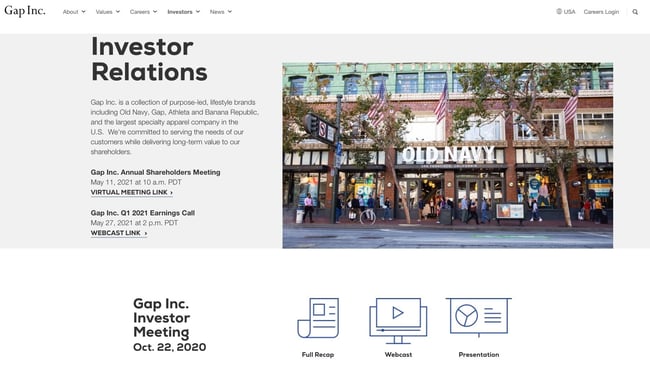 “Gap Inc. is a leading global retailer with a collection of brands including Old Navy, Gap, Banana Republic, and Athleta. We’re committed to serving the needs of our customers while delivering long-term value to our shareholders.”
“Gap Inc. is a leading global retailer with a collection of brands including Old Navy, Gap, Banana Republic, and Athleta. We’re committed to serving the needs of our customers while delivering long-term value to our shareholders.”
Gap is better known as a clothing brand, but the company behind it, Gap Inc, is a publicly traded firm with multiple successful brands under its belt. In its pitch to its potential investors, Gap Inc emphasizes its dominant position in the marketplace while ensuring that the company will be a secure long-term investment.
3. G2Crowd
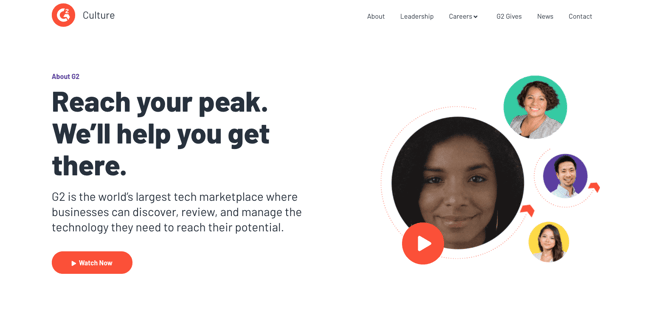 “G2 plays a huge role by providing unique, authentic peer advice in real time. We give buyers better guidance than traditional analyst firms, which can take up to 2 years to update and publish technology research. That timeline just can’t keep up with the pace of technology. At G2, we aim to be a trusted source that helps every business professional in the world make better technology decisions.”
“G2 plays a huge role by providing unique, authentic peer advice in real time. We give buyers better guidance than traditional analyst firms, which can take up to 2 years to update and publish technology research. That timeline just can’t keep up with the pace of technology. At G2, we aim to be a trusted source that helps every business professional in the world make better technology decisions.”
This is an interesting way to build your pitch: Make a note of what really annoys your customer and pitch how your service can resolve this grievance. It’s another way of reframing the customer’s needs, and it works because it’s a powerful way to describe the situation.
When they discuss how you’re being told by analysts what to do, or people who haven’t used a product, they highlight a clear disconnect in the market between what you need and what you get. The company allows verified users of products to write reviews and becomes an essential resource for their users.
4. Van Jones
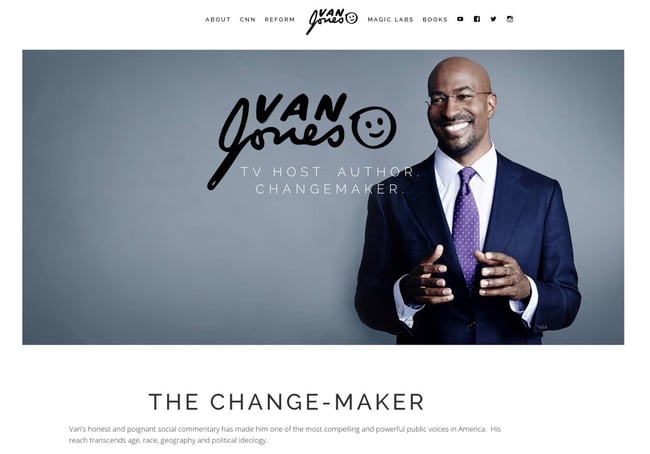 “Van’s honest and poignant social commentary has made him one of the most compelling and powerful public voices in America. His reach transcends age, race, geography, and political ideology.”
“Van’s honest and poignant social commentary has made him one of the most compelling and powerful public voices in America. His reach transcends age, race, geography, and political ideology.”
In this pitch to businesses and organizations looking for a speaker, Van Jones emphasizes his expertise — then highlights the fact that his reach will apply to everyone who listens to him. In a similar way, you can use the authoritativeness of your business to stand out, then turn around and address any concerns an organization might have about doing business with you. Here, Van Jones subtly addresses the current political climate by emphasizing that his speeches will resonate with anyone regardless of their background.
5. Edward Jones
 “Investing isn’t just about creating wealth. It’s about what money can help you do. Build a brighter future for yourself and your loved ones. Or design a better world for all of us. Our single focus is helping you achieve what’s most important to you.”
“Investing isn’t just about creating wealth. It’s about what money can help you do. Build a brighter future for yourself and your loved ones. Or design a better world for all of us. Our single focus is helping you achieve what’s most important to you.”
Edward Jones, a financial advising firm, creates a personal, resonant pitch by focusing entirely on the prospect or buyer. You rarely hear about them in this pitch, which is another great model to follow when creating your own pitch. While this is geared toward consumers rather than another business, it’s a great example of how you can write a pitch that resonates with your prospects while offering plenty of information about what you do.
6. Thrivent Financial
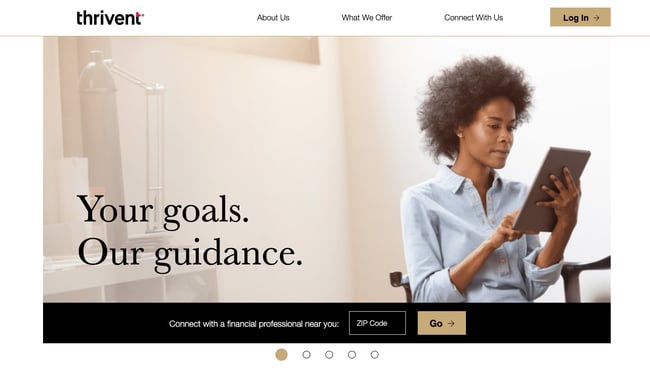 “We provide advice, banking, insurance, investment options, and guidance on how you can live generously. Money itself isn’t your end goal. (But it can help you get there.) Our financial guidance can help you move forward in life and reach your own higher purpose. We take the time to learn what matters most to you and provide resources that help you put your values into action.”
“We provide advice, banking, insurance, investment options, and guidance on how you can live generously. Money itself isn’t your end goal. (But it can help you get there.) Our financial guidance can help you move forward in life and reach your own higher purpose. We take the time to learn what matters most to you and provide resources that help you put your values into action.”
Thrivent Financial is another financial firm that focuses on the buyer in its pitch. Like in the previous pitch, it emphasizes helping prospects do what they most want to do after managing their finances. By implementing a similar strategy, you can craft your pitch so that prospects understand what they can achieve if they do business with you.
Product Pitch Examples
7.HubSpot
 “There’s a better way to grow. HubSpot offers marketing, sales, service, and operations software that helps your business grow without compromise. Because ‘good for the business’ should also mean ‘good for the customer.’”
“There’s a better way to grow. HubSpot offers marketing, sales, service, and operations software that helps your business grow without compromise. Because ‘good for the business’ should also mean ‘good for the customer.’”
First up is HubSpot’s very own product pitch. Short and to the point, this pitch tells businesses what it offers and the results it can drive both for the prospect’s business and their customers.
I can’t stress this enough: Help your customer understand what you do, who you do it for, and how in under two minutes. Your customer is busy and doesn’t have more than two minutes to spend with you. A short sales pitch helps you as a salesperson as well, because the faster you can disqualify people who aren’t interested in your offer, the faster you can reach someone who is.
8. Vidyard
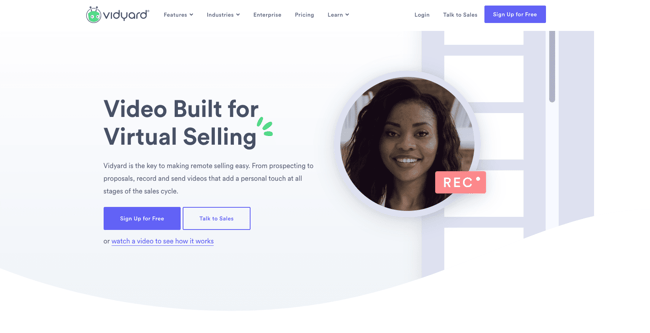 “Vidyard is the key to making remote selling easy. From prospecting to proposals, record and send videos that add a personal touch at all stages of the sales cycle. Email isn’t dead, but it sure is boring. With Vidyard, you can record and send videos in just a few clicks – perfect for busy sales reps trying to break into inboxes or marketers trying to make a splash.”
“Vidyard is the key to making remote selling easy. From prospecting to proposals, record and send videos that add a personal touch at all stages of the sales cycle. Email isn’t dead, but it sure is boring. With Vidyard, you can record and send videos in just a few clicks – perfect for busy sales reps trying to break into inboxes or marketers trying to make a splash.”
Vidyard is a company that’s been making waves — mainly because salespeople are finding video an effective prospecting tool. They found that great sales pitches are personalized, and what better way to do that than to add a human face to your message?
Their product pitch rocks not only because they identify their prospect clearly (sales reps who find email ineffective and time-consuming), but they also focus on the competitive advantage they have from the get-go. They don’t just sell this service, they “make remote selling easy” — and that makes a difference.
Leaving the discussion about competition too late in the conversation can also kill your sale. Vidyard knows this, which is why they make sure to include it in their pitch.
9. LISNR
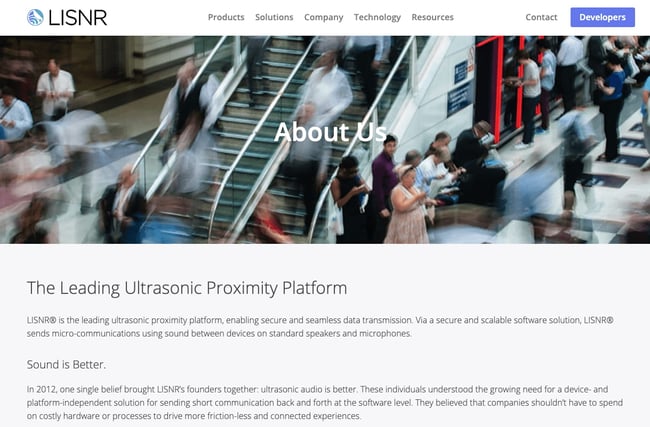 “In 2012, one single belief brought LISNR’s founders together: ultrasonic audio is better. These individuals understood the growing need for a device- and platform-independent solution for sending short communication back and forth at the software level. They believed that companies shouldn’t have to spend on costly hardware or processes to drive more friction-less and connected experiences.”
“In 2012, one single belief brought LISNR’s founders together: ultrasonic audio is better. These individuals understood the growing need for a device- and platform-independent solution for sending short communication back and forth at the software level. They believed that companies shouldn’t have to spend on costly hardware or processes to drive more friction-less and connected experiences.”
Found on the LISNR website, this product pitch uses their origin story to explain both how their organization came to be and what they aim to accomplish. This gives more context to their product, making purchasing with them more than just a transaction but also a contribution to a greater mission and belief system.
10. Xactly
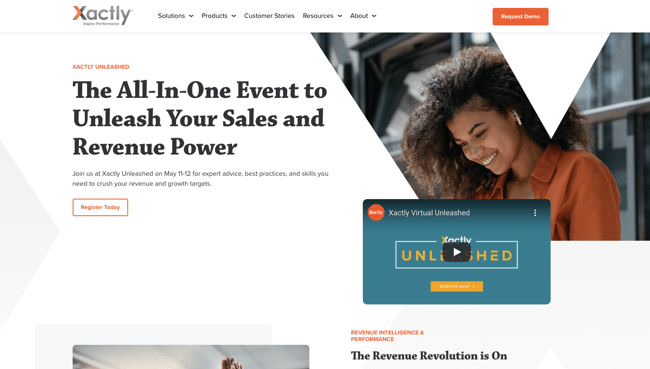 “We automate and streamline the commission process for sales organizations. For a lot of companies, that means getting you off an Excel spreadsheet or a home-grown cumbersome system. The Xactly advantage is that we’ve been in the cloud since 2005. We have been able to anonymize all of our customer’s data to allow you to leverage different data points when making your decision.”
“We automate and streamline the commission process for sales organizations. For a lot of companies, that means getting you off an Excel spreadsheet or a home-grown cumbersome system. The Xactly advantage is that we’ve been in the cloud since 2005. We have been able to anonymize all of our customer’s data to allow you to leverage different data points when making your decision.”
The Xactly pitch focuses on the problem their customer has — an important part of a successful pitch. I discussed the “me monster” above, and you should be wary of it when creating a pitch. Xactly does this well. The trick is to address your customer’s problems and concerns and highlight how your product or service solves these problems. In the case of Xactly, it’s about getting people off cumbersome legacy systems and Excel spreadsheets.
Why A Short Sales Pitch is A Good Pitch
An important note to make about these sales pitches is that they are all amazingly optimized for a short conversation. I can’t stress enough how much brevity matters for a sales pitch. Talking too much, using filler words, and talking about your company for more than two minutes can easily kill a conversation. So, keep your sales pitch short, clean, and simple! Your customers will thank you.
Editor’s note: This post was originally published in June 2019 and has been updated for comprehensiveness.

![]()


